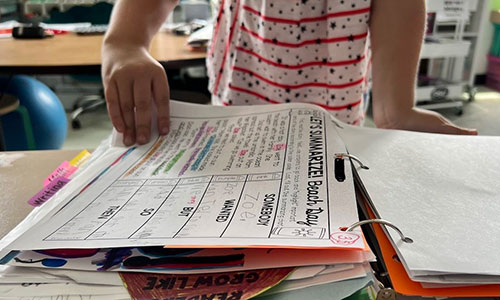
Too often, we educators find ourselves being bound by the number of days in a school year, the number of minutes in a staff development day, or even the pressure of mandated deadlines for specific academic benchmarks. While these variables play a crucial role in developing and maintaining a professional learning cycle—especially a cycle that prioritizes taking assessment beyond the testing window—it is essential to note that these efforts should be part of a broader system and tie together a district’s ability to provide focused and comprehensive support for all educators on an ongoing basis.
By fostering a culture of data use and continuous job-embedded professional learning opportunities, districts can enhance strategic initiatives to go beyond specific times of the year. Establishing opportunities for educators to engage in professional learning that is connected to key district metrics or priorities provides a systematic approach for real-time support, applicable tools and strategies, and deeper understanding for all educators within the community.
A sample scenario
Consider the following, a common scenario for many school districts across the country.
Several weeks after the end of a school year, district leaders gather to refine their goals for the upcoming academic year. Each administrator comes to the table ready to help prioritize initiatives, allocate resources, and support district efforts that help to advance the strategic mission of helping all students learn and closing the achievement gap for all students. This planning session is fueled by the district’s historic summative and interim assessment data, observations from administrators, community feedback, department initiatives, school site requests, and teacher insights.
After several weeks of planning and preparation, the district finalizes its plan to streamline the lesson planning process across all school sites through a focused district-wide approach to professional learning communities (PLCs). One of the core components of the district’s PLC process is how schools will leverage their interim assessment data. Educators will need to measure progress, inform instruction, and communicate student achievement with families over the year. District leaders determine that all educators must engage in professional learning during the fall kick-off event. Additionally, leaders have planned professional learning sessions during the school year to align with the interim assessment window: fall, winter, and spring.
With a focus on PLCs, and a calendar for support sessions for all educators, the district plans for a strong kick-off meeting in the fall, with a focused initiative grounded by an interim assessment window to make the PLC process both actionable and meaningful for educators. The objective of this development series is to be grounded in the interim assessment calendar to tie data analysis and planning together. While this approach is most likely going to yield successful results for students and teachers, it is also a prime example of how professional learning can be solidified in a comprehensive manner throughout the course of the year, outside the assessment window, and within the day-to-day business of school and instruction.
Fostering a culture of data use and learning
In keeping with this scenario, let’s consider a third-grade teacher who has the opportunity to engage in two focused professional learning days geared toward aligning with the district’s PLC process and how this helps foster a culture of data use and learning in her school.
Ms. Jones has seen the new planning process and is excited to be able to engage in common planning time with her other third-grade teachers. Additionally, she has used her fall interim assessment data in her latest PLC meeting to help align conversations around students’ abilities as they currently relate to the Common Core standards Operations and Algebraic Thinking and Reading Informational Text. The third-grade team meets to establish some common goals for their team and decides to set individual student goals based on fall assessment scores. During their conversations, Ms. Jones expresses excitement in seeing how students grow from fall to winter and says she can’t wait to come back as a team and share all the growth.
Data exists in every aspect of the work and is not tied solely to a specific assessment or time of year. Ms. Jones and her third-grade team are collecting all sorts of data every day of the week. What students were here today? How many students were able to answer our warm-up question? What percentage of the class got question 13 correct? This type of data collection is invaluable for educators. Fostering a culture of data use and continuous learning allows educators, like Ms. Jones, to align their day-to-day practice with district priorities, such as PLCs. For example, a systematic approach throughout the district could allow for PLC conversations to focus on formative assessment strategies that are connected to trends seen within a school, grade-level, or even classroom.
During their next PLC, Ms. Jones and her third-grade team come with their curriculum and a copy of the end-of-unit assessment. It is still about nine weeks until the school administers the winter interim assessment, so there is still a good chunk of time until she and her peers get trained on the next step in the PLC cycle. However, this PLC meeting has now grown to include the building leader and instructional coach.
During the regular planning conversation, the building principal leverages her district conversation guide to help prompt the team to consider what specific skills are being assessed at the end-of-unit summative assessment. Ms. Jones and her team identify several skills: multiplication, addition, and subtraction. The principal then asks the team, “What standards are those skills aligned to, and when are we teaching those lessons?” This series of prompting questions provides the teachers with the opportunity to dig into their lesson plans and agree upon a series of common formative assessments they can give to help track progress between interim assessment windows. During the next few PLC meetings, teachers bring formative data and determine the types of scaffolds needed, as well as the pace the grade level needs to take when teaching specific concepts.
Providing the opportunity for leaders to model and engage in a culture of data analysis allows for deeper connection and impact as it relates to a district’s mission. Providing a systematic approach to professional learning tied to the PLC process is beneficial to ensure understanding. However, real-time professional learning opportunities in the daily practice of educators allow for immediate response and impact. Connecting daily practices—in this case, data collection and planning—to the larger goals of the district, i.e., PLC processes, allows educators to make explicit connections from their work to the broader mission of the district. Additionally, these daily opportunities help to reinforce a culture of data use and continuous learning for all educators.
Key consideration for district leaders: How can we, as a district, promote a culture of data use and responsive development within our current initiatives?
Establishing personalized and job-embedded professional learning
After Ms. Jones, her fellow third-grade teachers, and all the educators across the district engage in their PLCs, how can leaders be sure that each individual has the understanding and tools necessary to engage fully? Job-embedded professional learning opportunities allow educators to get the right amount of support based on their individual needs. District leaders may, understandably, be concerned with the resources required to support differentiated and job-embedded professional learning sessions for every educator.
Consider a middle school near Ms. Jones’ elementary school. Riverview Middle School’s principal, Ms. Johnson, attends the ELA PLCs and uses the streamlined process we saw with Ms. Jones and her third-grade team. Ms. Johnson leverages the PLC conversations to help inform the date and time she visits classrooms to engage in instructional rounds.
Based upon the days the seventh-grade ELA team identifies what they are going to teach and when, Ms. Johnson calendars a 10–20 minute block of time where she can go in and see the instruction that has been planned as a grade level. During her instructional rounds, Ms. Johnson collects her own set of data: What was the standard being covered? What strategies is the teacher using to promote deeper understanding? Are students engaged in their learning? What formative checks are being utilized to track progress throughout the lesson?
Collecting the data does not constitute professional learning or job-embedded support. However, Ms. Johnson uses her observations to establish trend-level data, inform staff of professional learning days, guide planning questions during PLC discussions, and provide individual coaching cycles for educators. As the principal of a middle school, Ms. Johnson is pulled in many different directions every day. However, through a systematic approach to instructional rounds, she can tie her observations and next steps to what each teacher needs based on their current level of understanding.
Context matters, and educators want to apply their learning to their day-to-day practice. Designing professional learning to consider the specific needs of schools, teachers, and students—based on data tied to current initiatives—allows for a comprehensive system of support for all educators. Supporting differentiated learning opportunities (e.g., coaching, mentoring, or peer-led learning communities) gives districts a vantage point on how to support job-embedded supports across all campuses.
Key consideration for district leaders: How can we differentiate learning opportunities and structure embedded modalities for support?
Conclusion
District leaders should reflect on their current focus, systems, and resources. Based on the current strategic vision and priorities, district systems can be designed to connect all professional learning opportunities comprehensively and streamlined. Building a culture of data use and providing differentiated learning allows educators to leverage their context and connect their efforts directly to the initiatives of each district.
If your district tests with MAP® Growth™ or MAP® Reading Fluency™, we encourage you to consider our professional learning offerings that can help you make good use of assessment data all year long. Our professional learning focuses on MAP Growth and MAP Reading Fluency reports, strategies for informing instruction, and more. You may also find our School and District Leaders Hub useful.






